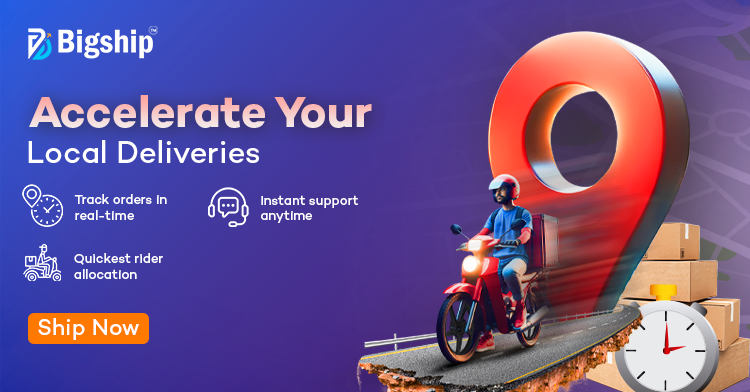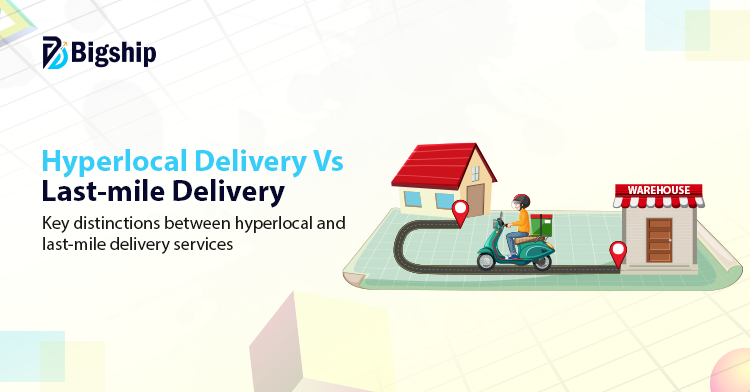Online shopping has changed how we buy things, but how they reach us depends on different delivery models. Two key ones are hyperlocal delivery service and last-mile delivery. But what is hyperlocal delivery, and how does it differ from last-mile logistics?
To put it simply, hyperlocal refers to deliveries made within a short distance, usually from local stores to customers in the same area. On the other hand, last-mile delivery covers a broader area, often involving large warehouses and longer transit times.
In this blog, we’ll explore their meanings, differences, and future trends to help you understand which model suits modern e-commerce needs.
What’s Hyperlocal Delivery?
Hyperlocal delivery is a way to get products from a nearby store or address to your customer’s doorstep in a short time. Unlike regular deliveries that come from far-off warehouses, hyperlocal delivery operates within a small area, usually within 15 to 50 kilometers.
For example, if you order fresh vegetables from a local grocery store, Or if you want to send a shipment locally to your customer a delivery agent quickly delivers it, often within an hour or two. That’s hyperlocal delivery meaning – quick, local, and direct.
This model helps small businesses sell faster and ensures you get essentials without long waits. It is widely used for groceries, medicines, food, and other daily needs that require immediate delivery.

What’s Last-mile Delivery?
Last-mile delivery is the final step in getting a package to you. After an order arrives at a nearby hub, a delivery agent picks it up and brings it straight to your doorstep. This is the part of the process you see the most, that is, the courier handing over your package.
For instance, you order a gadget online. It travels from the seller’s warehouse to a major distribution center. From there, a local delivery person picks it up and brings it to your home. That last stretch, from the local hub to your hands, is last-mile delivery.
How Hyperlocal Delivery Services Help E-commerce Businesses?
Hyperlocal delivery services are changing how businesses fulfill orders. Instead of sending packages or products from distant locations, businesses deliver from local or nearby locations. This saves time, lowers costs, and improves customer satisfaction. Let’s look at the key benefits of using hyperlocal delivery for e-commerce.
Lower Shipping Costs: When shipments or products come from a local area or store, the delivery distance is shorter. This cuts down the need for expensive transport, thus reducing shipping costs. Unlike traditional shipping, where packages travel long distances, hyperlocal delivery eliminates extra transportation.
Faster Deliveries: Speed is the biggest advantage of hyperlocal delivery service. Orders are delivered within 15 to 50 kilometers, usually in under 2 hours. This is much faster than standard deliveries, even same-day options.
Better Customer Experience: Nobody likes waiting too long for an order. Delayed deliveries frustrate customers and reduce trust. Since hyperlocal delivery speeds up shipping, customers receive their orders on time. This improves their shopping experience, thus, making them more likely to return and order again.
More Sales for Local Stores: Local businesses benefit too. Hyperlocal delivery connects them with online shoppers, which helps them sell more products. Small stores that once depended only on walk-in customers can now reach a wider audience.
Difference Between Hyperlocal and Last-Mile Delivery
Delivery plays a crucial role in e-commerce, and businesses use different models to ensure customers get their orders on time. Two common methods are hyperlocal delivery and last-mile delivery. Let’s understand basic point of differences between both.
| Hyperlocal Delivery | Last-mile Delivery |
| Orders are delivered within 30 minutes to 2 hours, depending on the location. | Delivery takes 12 to 16 hours or even a full business day, especially in metro cities with heavy traffic. |
| Covers a 5-15 km radius from the seller’s location, sometimes extending up to 50 km for intra-city deliveries. | The delivery area is larger and determined by a central hub. |
| Usually limited up to 20 kgs, as deliveries are often made using two-wheelers, three-wheelers, or small vehicles. | No strict weight limit. Charges depend on the volumetric weight, and items of all sizes can be shipped. |
| Used for fast-moving essential items like groceries, medicines, fresh food, and daily-use goods or shipments that need to be sent locally. | Can deliver a wide range of products, including furniture, appliances, electronics, clothing, and more. Perishable goods are rarely included. |
Future Trends in Hyperlocal and Last-Mile Delivery
The delivery industry is evolving rapidly, with both hyperlocal delivery services and last-mile logistics adapting to new technologies and customer expectations. Faster deliveries, automation, and sustainability are shaping the future.
Technology is also making a huge impact. Companies are testing drones, autonomous vehicles, and AI-powered route optimization to reduce costs and speed up deliveries. Amazon and FedEx are already experimenting with drone deliveries.
Sustainability is another priority. From electric delivery vehicles to eco-friendly packaging, logistics providers are working towards greener operations to reduce carbon emissions.
Both hyperlocal and last-mile delivery are moving towards faster, smarter, and more efficient systems to keep up with the future of e-commerce.
Conclusion
Both last-mile and hyperlocal delivery services play key roles in e-commerce, but they serve different needs. While last-mile delivery ensures products reach customers from warehouse across cities, hyperlocal delivery focuses on quick, short-distance shipments, often within hours. Understanding these differences helps businesses choose the right logistics model to meet customer expectations.
As fast and efficient deliveries become a priority, businesses need a reliable logistics partner. Bigship offers efficient hyperlocal delivery services to help you reach customers quickly.
Sign up today and simplify your hyperlocal shipping with Bigship!
FAQs
What is hyperlocal delivery?
Hyperlocal delivery is a fast shipping model where products are delivered within a small geographic area, usually within 2 hours.
Can heavy items be delivered through hyperlocal delivery?
Usually, there’s a weight limit 20 kgs since deliveries are done using bikes or small vehicles.
How is hyperlocal delivery different from last-mile delivery?
The basic difference between both is that hyperlocal delivery covers short distances with super-fast deliveries, while last-mile delivery covers larger areas and takes longer.





